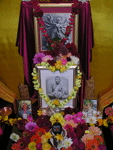Satsang Notes from Babaji’s Autumn Teaching Visit to the SRV Mainland Ashrams
What is the difference between Babaji’s classes and satsangs? From our notes it is not so obvious, to be sure. During weekend classes in the ashram, Babaji delivers 3 hours of teachings. We ready ourselves for this and practice concentration. In the early days it seemed very difficult to take in so much indepth knowledge in one sitting (with a break!), but over time we became acclimatized to it. We learned to accept as much as we could receive and trust the rest would work its way into our understanding. Babaji calls this the “sponge method.” Repetition is the salt of spiritual life. Anyone who has studied years with a teacher ends up being grateful for all the repetition, for it creates links, unseen at first, in our minds, and as more teachings come over the months and years, they link up with these certain foundational links. Sometimes a link will sit there for years until the perfect auspicious moment when a situation or train of thought suddenly brings it to the surface of consciousness and a new plateau of understanding is revealed. We call Babaji’s three-hour classes a “pleasant austerity” and delight in the intense Wisdom atmosphere we experience in them.
Satsangs, on the other hand, are more informal and are an opportunity for students to ask questions about what we heard in class, what we have studied on our own, or even questions arising from daily life. SRV satsangs are generally held after arati, an evening devotional service where elements, senses, and our minds and hearts are surrendered to God and we offer the traditional arati hymn, Om Hring Ritang, to Sri Ramakrishna. Then we retire to the back of the shrine room. Babaji opens with a brief and spontaneous discourse to help set the atmosphere for peoples’ questions. The notes below are highlights from these short discourses and his responses to questions.



